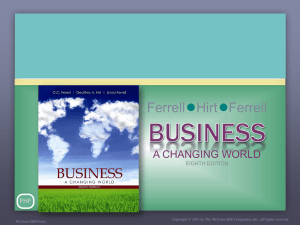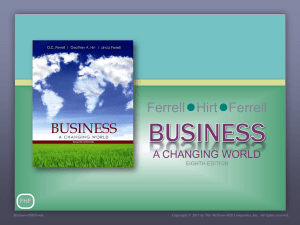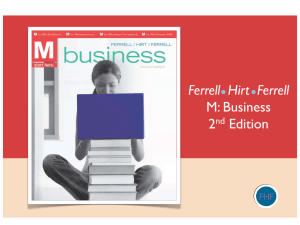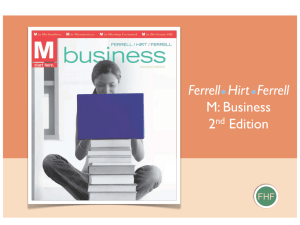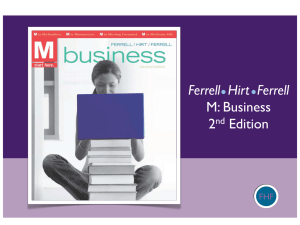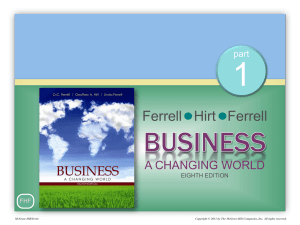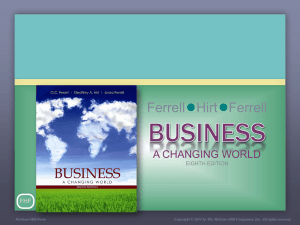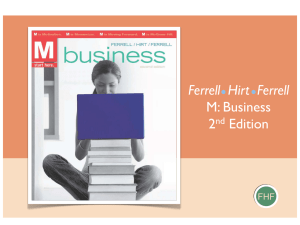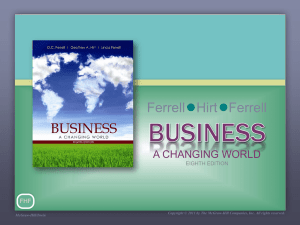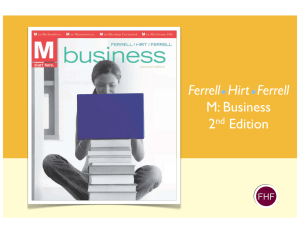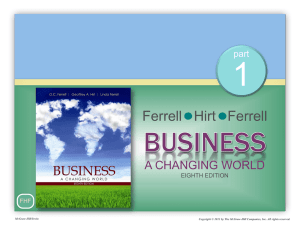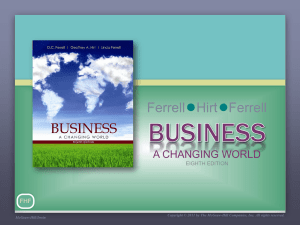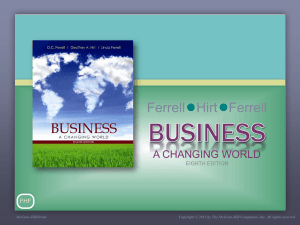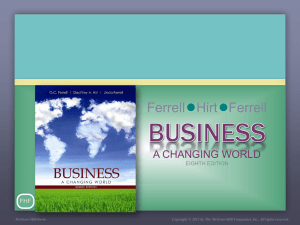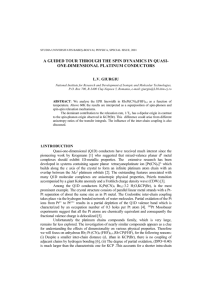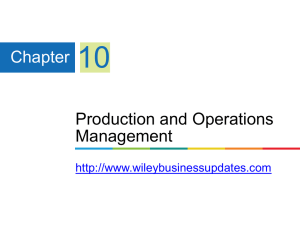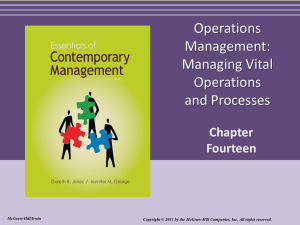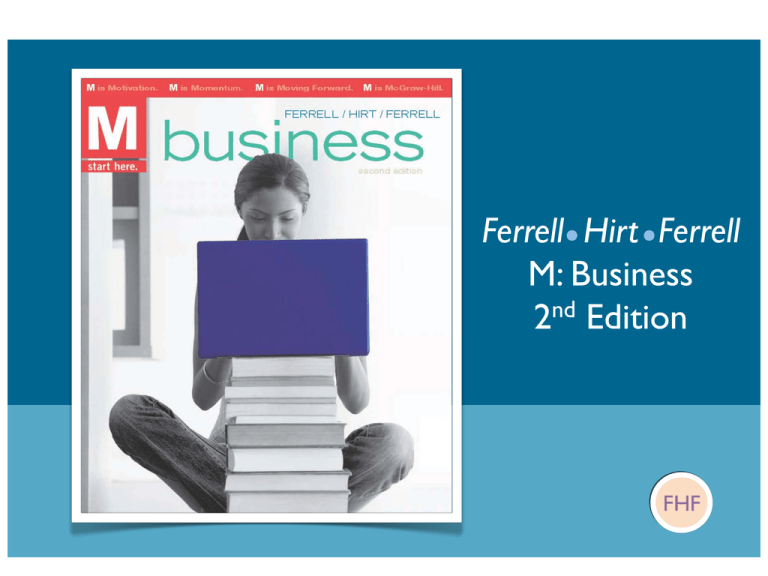
Ferrell Hirt Ferrell
M: Business
nd
2 Edition
FHF
Managing Service
and
Manufacturing Operations
FHF
McGraw-Hill/Irwin
Copyright © 2011 by the McGraw-Hill Companies, Inc. All rights reserved.
Operations Management
Development and administration of the activities involved in
transforming resources into goods and services
• Historically called production or manufacturing
• Change to operations = focus on goods & services
• Emphasis on viewing the operations function as a whole
Manufacturing/Production
• Activities and processes used in making tangible products
Operations
• The activities and processes used in making both
tangible and intangible products
FHF
9-3
Transformation Processes of Operations
Management
FHF
9-4
Inputs
• The resources (labor, materials, energy, etc.) that are
converted into outputs
Outputs
• The goods, services, and ideas that result from the
conversion of inputs
FHF
9-5
Service Businesses
• Salons, colleges, airlines
• 70% of all employment in the United States;
fastest growth market for jobs
• Represent over 72% of GDP in U.S.
FHF
9-6
Services Are...
• Generally intangible
• Perishable
• Demand can be variable
• Cannot be saved, stored, resold, or packaged
FHF
9-7
Manufacturing
Service
• Tangible
• Intangible
• Uniform inputs
• Customized inputs
• Uniform outputs
• Customized outputs
• Less labor intensive
• More labor intensive
• Easy to measure
• More difficult to measure
productivity
productivity
(due to variations in demand, service,
requirements and intangibility)
FHF
Manufacturing Versus Service Products
9-8
Planning the Product
What do consumers want?
Develop the product
• Can be a long and expensive process
Turn product ideas into workable design
• The job of engineers and research and development departments
FHF
9-9
Designing Operations Process
Standardization
• The making of identical interchangeable
components or products. Faster, reduces
production costs
Modular Design
• Creation of an item in self-contained units that can
be combined or interchanged to create different
products
FHF
9-10
Designing Operations Management
(continued)
Customization
• Making products to meet a particular customer’s
needs or wants
Mass Customization
• Making products to meet needs or wants of a large
number of individual customers.
FHF
9-11
Capacity
Maximum load that an organizational unit can carry or
operate
• Hershey’s production capacity
• 33 million Hershey’s kisses per day
• 12 billion per year
FHF
9-12
Planning Facilities
Facility location
• High costs involved
Pay attention to
• Proximity to market
• Availability of raw materials, transportation, power, labor
Climatic influences
• Community characteristics
• Taxes and inducements
FHF
9-13
Facilities Layout
• Fixed-Position Layout
• Project Organization
• Process Layout (intermittent organizations)
• Product Layout (continuous manufacturing
organization)
FHF
9-14
Facilities Layout (continued)
Fixed-Position Layout--Project organization
• All resources needed for a product are brought to a central
location
Process Layout--Intermittent organization
• Layout is organized into departments that group related
processes
Product Layout--Continuous manufacturing organization
• Production is broken down into relatively simple tasks assigned
to workers positioned along a line
FHF
9-15
Technology
Basic underlying technology dictates each industry’s
transformation process
Flexible manufacturing
• The direction of machinery by computers to adapt
to different versions of similar operations
Computer-integrated manufacturing (CIM)
• A complete system that designs products, manages
machines and materials, and controls the operations
function
FHF
9-16
Supply Chain Management
[
Connecting and integrating all
parties or members of the
distribution system in order to
satisfy customers
]
FHF
9-17
Purchasing
Buying of all materials needed by the organization
• Desired quality
• Correct quantities
• Lowest cost
Otherwise known as Procurement
FHF
9-18
Inventory
All raw materials, components, completed or partially completed
products, and pieces of equipment that a firm uses
Inventory control
• Process of determining how many supplies and goods are needed
and keeping track of quantities on hand, where each item is, and
who is responsible for it
FHF
FHF
9-19
Supply Chain Management
Economic order quantity model
• A model that identifies the optimum number of
items to order to minimize the costs for managing
them (ordering storing, and using)
Just-in-Time inventory management
• Eliminates waste by using smaller quantities
arriving “just in time” for use in the transformation
process.
FHF
9-20
Material-Requirements Planning
[
Planning system that schedules the
precise quantity of materials
needed to make the product.
]
FHF
9-21
• Numi Organic Tea strives to achieve a sustainable, eco-
friendly supply chain
• Performs an annual Eco-Audit
• Tracks environmental impact of its manufacturing and supply
chain
• Offset all of its emissions in 2009
• Honored by the Waste Reduction Awards Program 4 years
in a row
FHF
9-22
Outsourcing
• Increasingly a part of supply chain management in
operations
• Outsource aspects of operations to companies that
provide products more efficiently, at lower cost, greater
customer satisfaction.
FHF
9-23
Routing & Scheduling
Routing
• Sequence of operations through which the product
must pass
Scheduling
• The assignment of required tasks to departments or
specific machines, workers, or teams.
FHF
9-24
Program Evaluation and Review Technique
(PERT)
[
Identifies major activities required to
complete a project, determines the
critical path, and estimates time needed
to finish
]
FHF
9-25
Hypothetical PERT for a Hamburger
FHF
9-26
Quality
Degree to which a good or service meets the demands
and requirements of customers.
• A critical element of operations management.
FHF
9-27
Malcolm Baldridge National Quality Award
Criteria:
• Leadership
• Information and analysis
• Strategic planning
• Human resource development
• Process management
• Business results
• Customer focus & satisfaction
FHF
9-28
Managing Quality
Quality Control
• Processes an organization uses to maintain its
established quality standards.
Total Quality Management (TQM)
• Philosophy that uniform commitment to quality
will promote a culture that meets customers’
perceptions of quality
Statistical Process Control
• System to collect and analyze information about
production processed to pinpoint quality
problems in the system.
FHF
9-29
Establishing Standards
• ISO 9000
• International Organization for Standardization
(ISO) system of quality management standards
designed to ensure the customer’s quality standards
are met
FHF
9-30
ISO System Categories
• Incorporates standards from 162 countries
• World’s largest developer and publisher of
international standards
• Plan, Do, Check, Act (PDCA) Cycle
• Operating principle for ISO
• Plan: Establish objectives
• Do: Implement plans
• Check: Measure results
• Act: Correct and improve plans
FHF
9-31
Inspection and Sampling
Inspection
• Reveals whether a product meets quality standards.
Sampling
• How many items should be inspected. Depends on
potential costs of product flaws in terms of human lives
and safety.
FHF
9-32
FHF
9-33

